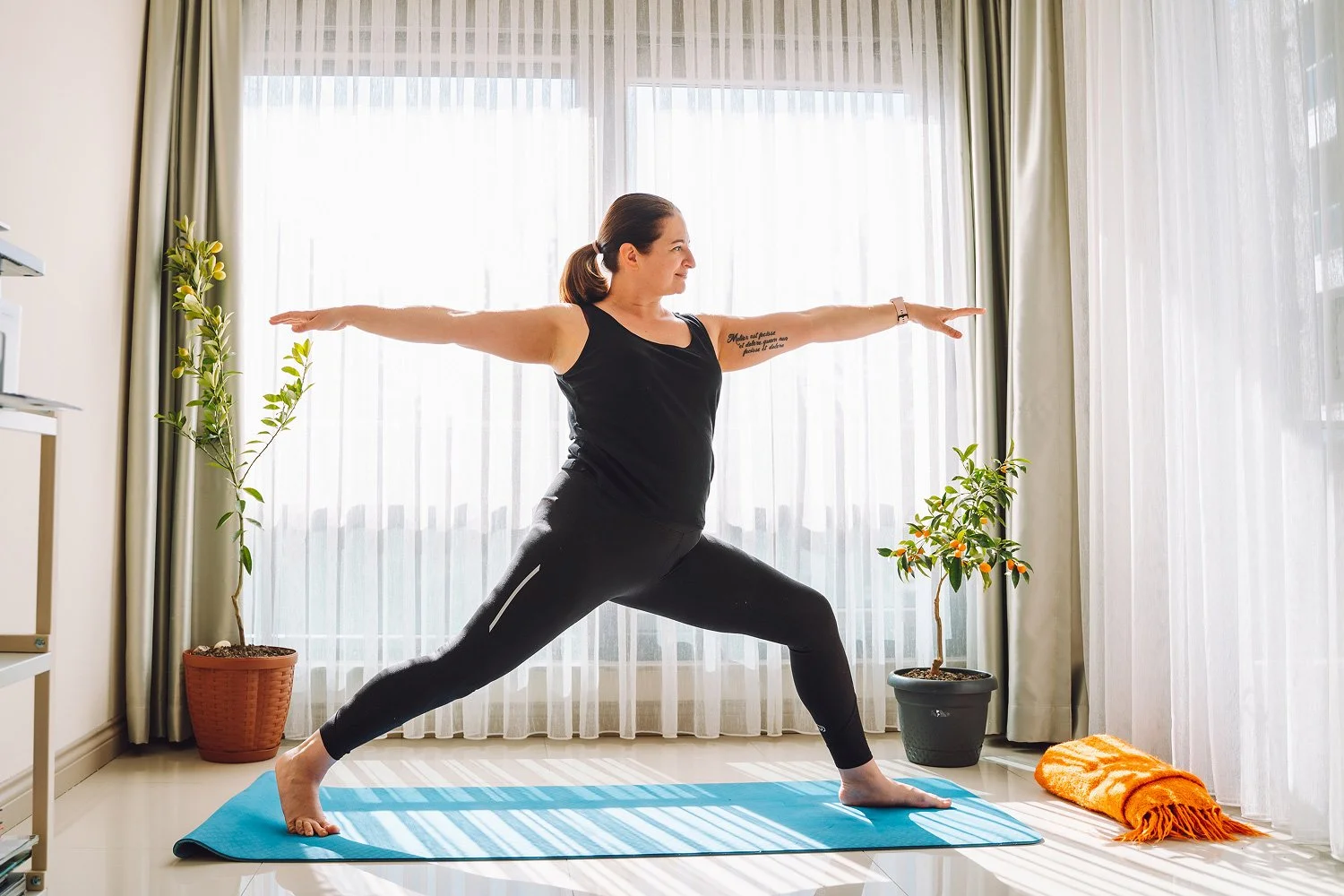Yoga for stress relief: 6 poses to help you find your calm

Clinically reviewed by Dr. Chris Mosunic, PhD, RD, MBA
If you’re in need of some stress relief—and who isn't—you may want to give yoga a try. Learn why yoga can help you de-stress and get 9 tips to help you try it for yourself.
If you’ve ever found yourself staring at your screen—holding your breath, shoulders tense, mind racing—then you know firsthand how stress can show up in daily life. And even when you get a break, your body may still be bracing for the next (inevitable) thing.
With all of the ways stress can live in your body, it’s no surprise that physical practices are so beneficial. Even just a few minutes of mindful movement or breathing can help shift your state — physically, mentally, emotionally. Yoga can be that simple practice, inviting you to slow down, release tension, and reconnect with yourself.
Let’s explore how yoga can help relieve stress and how to try it for yourself. Whether you’re new to the practice or just curious about how it might help, here’s everything you need to know to get started.
Does yoga alleviate stress?
When you’re stressed, your body enters a fight-or-flight state which often means your heart rate speeds up, your breath gets shallow, and your muscles tense. This response is very helpful in emergencies, but many of us live in this state far too often and, over time, it can wear you down.
Which is where yoga can help. Yoga helps to activate your parasympathetic nervous system, which can lower your stress hormones like cortisol. It also can help to improve heart rate variability, reduce symptoms of anxiety and depression, and increase mindfulness. As a result, it can help to improve emotional regulation and resilience as well.
The combination of gentle physical activity, intentional breathing, and present-moment awareness all lead to these benefits. These elements can work together to create a sense of calm and safety in the body — even if your external circumstances haven’t changed all that much.
6 yoga poses to help you de-stress
So now that we’ve established that yoga can help alleviate stress, let’s dive into where to get started. Here are six yoga poses that can help you feel more grounded and restore your energy:
1. Child’s pose: This is a resting posture that gently stretches your back and hips while offering a sense of calm. To do it, kneel on the floor, bring your toes to touch, and fold forward with your arms stretched out in front or resting by your sides. Then, breathe into the back of your body.
2. Legs up the wall: Find a wall and lie down on your back, then scoot your hips close and rest your legs vertically against the wall. This pose can help improve your circulation and calm your nervous system.
3. Seated forward fold: Sit with your legs extended straight in front of you, and gently hinge forward from your hips. As you do this, let your hands rest wherever they land. Then, let your head drop and breathe into your back body. This pose can soothe your mind and ease tension in your spine.
4. Cat-cow: Start on your hands and knees. On an inhale, arch your spine and lift your chest (cow). Then on an exhale, round your spine and tuck your chin (cat). Repeat this slowly and sync your breath with each movement. This flow helps bring mobility to your spine and invites presence.
5. Bridge pose: Lie on your back with your knees bent and your feet hip-width apart. Keep your arms alongside your body. Then press your feet into the floor and lift your hips, creating a gentle backbend. This pose can open your chest and help you to release stress stored in the shoulders and hips.
6. Corpse pose: Lie on your back with your arms relaxed by your sides and legs slightly apart. Then let your body melt into the ground, and breathe. A few minutes here can help your body shift into deep rest.
As a rule of thumb, if one of these poses feels particularly comforting, linger there. And if another one doesn’t, skip it. Let your body be the guide.
How to use yoga for stress relief: 9 tips to get started
The great thing about yoga is that you don’t need to devote a ton of time to feel relaxed. In fact, it’s possible to feel the benefits in as little as two minutes.
Here are some options you can explore as you start your practice. There’s no pressure to do them all — pick and choose which feel most supportive to you. We’re trying to lower stress, after all.
1. Start small and stay consistent
If a full yoga class feels like too much for you, start with doing two minutes of movement or breathwork at home. The idea is to build a habit that feels manageable, not one that adds pressure to your day.
Try this: Do one minute of cat-cow stretches when you get up in the morning, or take three deep breaths in child’s pose before you head to bed.
💙 Get started by Releasing Stress with Mel Mah.
2. Create a space that feels calming
Choose a spot in your place with enough room to move and as few distractions as possible. Dim lighting and your favorite relaxing playlist can also help.
Try this: Light a candle or incense to fill your space with a relaxing smell if that feels comforting to you.
💙 Press play on Mel’s Movement Music to get your body moving.
3. Focus more on how it feels than how it looks
Yoga is about sensation, not appearance. Focus less on nailing the perfect pose and instead aim to feel grounded and open.
Try this: Close your eyes during a pose and notice where you feel tension releasing. Avoid looking at yourself in the mirror if that will get you in your head.
4. Let your breath lead the way
Make your breath your anchor. Intentional breathing—especially slower exhales—can help calm your nervous system and regulate your stress hormones.
Try this: Inhale for four counts and exhale for six counts. Then repeat this for a few rounds in any pose, or even while driving to the store.
Read more: 7 deep breathing exercises to help you calm anxiety
5. Try gentle or restorative yoga styles
If stress is your main concern, skip the power flows and try something slower. Hatha, Restorative, and Yin yoga are all designed to support relaxation and regulate your nervous system.
Try this: Try looking for a local yoga class or studio in your area. You can also inquire if they have classes specifically directed at stress relief.
💙 Explore Softening Anxiety from the Daily Move with Mel Mah.
Read more: Yoga for relaxation: 5 simple, stress-relieving poses
6. Be flexible with when and how you practice
Morning movement can help you start the day grounded whereas evening poses can support deeper sleep. Midday stretches can also help energize you through an afternoon slump, or calm you through an anxiety spike. So, try different times and see what fits best into your life.
Try this: Do one pose when you wake up, one during a lunch break, and one right before bed. Notice how each affects you, and adjust accordingly depending on the day and how you feel.
7. Use props to support your body
Props like cushions, yoga blocks, and even a stack of books can help make poses more accessible and comfortable.
Try this: Place a pillow under your knees during savasana, or use a blanket under your hips in seated poses.
Related read: Restorative yoga: what it is, benefits and 5 relaxing poses
8. Pair yoga with something you already do
Building a new habit is easier when you link it to something you already do regularly. This is called “habit stacking,” and it can make your practice a lot more sustainable.
Try this: After brushing your teeth or getting dressed for the day, do one minute of deep breathing. You could also do a forward fold and stretch for a bit after you end work for the day.
9. Approach it with curiosity
Remind yourself that if your mind wanders or your body feels stiff, that’s okay. Yoga is a practice, not a performance. Each time you return to your breath, you’re doing it right.
Try this: Replace “I need to do yoga” with “I wonder how I’ll feel after a couple of deep breaths.”
Yoga for stress relief FAQs
What type of yoga is best for stress relief?
Slower-paced styles of yoga tend to be the most supportive when you’re feeling stressed. Hatha yoga is slower than vinyasa and gives you time to focus on your breath and alignment, making it a good type to start with. Restorative yoga can also be great because it uses props to help your body fully relax. If you’re comfortable holding poses for a long time to gently stretch your muscles and invite stillness into your day, consider trying yin yoga.
But really, the best yoga for stress is just the one that feels good to you and helps you feel more at ease afterward.
Do I need to be flexible to try yoga for stress relief?
You don’t need to be flexible to try yoga. In fact, flexibility isn’t even the goal — it’s about building awareness. Yes, a lot of people practice yoga to improve their mobility over time, but that’s a side benefit.
So, if a pose doesn’t feel accessible to you, don’t sweat it. There are many modifications and props that can help. Plus, making adjustments to meet your body’s needs is actually a big part of the practice. If you’re breathing and paying attention, then you’re already practicing yoga.
What are the best yoga poses to de-stress?
Typically, the most effective poses for stress relief are the ones that allow your body to relax and your breath to slow down. Child’s pose, legs up the wall, and savasana are especially supportive. These poses can help calm the nervous system, ease muscle tension, and encourage a sense of safety.
Gentle seated forward folds and supported backbends can also help release physical and emotional holding. But it really depends on how you’re feeling day to day, so try a few and notice which one feels the most grounding.
Can yoga breathing lower anxiety and stress?
Yoga breathing can help to lower your anxiety and stress — and it can often do it very quickly. Breathwork is one of the most powerful and accessible tools in yoga for calming your mind and body.
When you’re stressed, your breath tends to become shallow and rapid. This sends signals to your brain that something is wrong and keeps you in a heightened state of alert. But if you slow down your breath, it can help shift your nervous system into a more relaxed state.
Some techniques that can be especially effective are alternate nostril breathing and 4–6 breathing, which is inhaling for four counts and then exhaling for six counts.
How often should I practice yoga to relieve stress?
There isn’t a one-size-fits-all answer here. For some people, a short daily practice works great. For others, a few times a week is their ideal. Really, what matters most is finding a rhythm that feels sustainable to you.
Consistency matters more than duration. So, start with what feels doable, and then build from there. The goal is to make yoga a supportive part of your life and not another thing to add to your to-do list.
Calm your mind. Change your life.
Mental health is hard. Getting support doesn't have to be. The Calm app puts the tools to feel better in your back pocket, with personalized content to manage stress and anxiety, get better sleep, and feel more present in your life.






